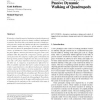Free Online Productivity Tools
i2Speak
i2Symbol
i2OCR
iTex2Img
iWeb2Print
iWeb2Shot
i2Type
iPdf2Split
iPdf2Merge
i2Bopomofo
i2Arabic
i2Style
i2Image
i2PDF
iLatex2Rtf
Sci2ools
IJRR
2010
2010
Stability Analysis of Passive Dynamic Walking of Quadrupeds
We introduce a detailed numerical simulation and analysis framework to extend the principles of passive dynamic walking to quadrupedal locomotion. Non-linear limit cycle methods are used to identify possible gaits and to analyze the stability and efficiency of quadrupedal passive dynamic walking. In doing so, special attention is paid to issues that are inherent to quadrupedal locomotion, such as the occurrence of simultaneous contact collisions and the implications of the phase difference between front and back leg pairs. Limit cycles identified within this framework correspond to periodic gaits and can be placed into two categories: in-phase gaits in which front and back legs hit the ground at roughly the same time, and out-of-phase gaits with a 1902 phase shift between the back and front leg pairs. The latter are, in comparison, energetically more efficient but exhibit one unstable eigenvalue that leads to a phase divergence and results in a gait-transition to a less efficient in-p...
| Added | 28 Jan 2011 |
| Updated | 28 Jan 2011 |
| Type | Journal |
| Year | 2010 |
| Where | IJRR |
| Authors | C. David Remy, Keith W. Buffinton, Roland Siegwart |
Comments (0)

